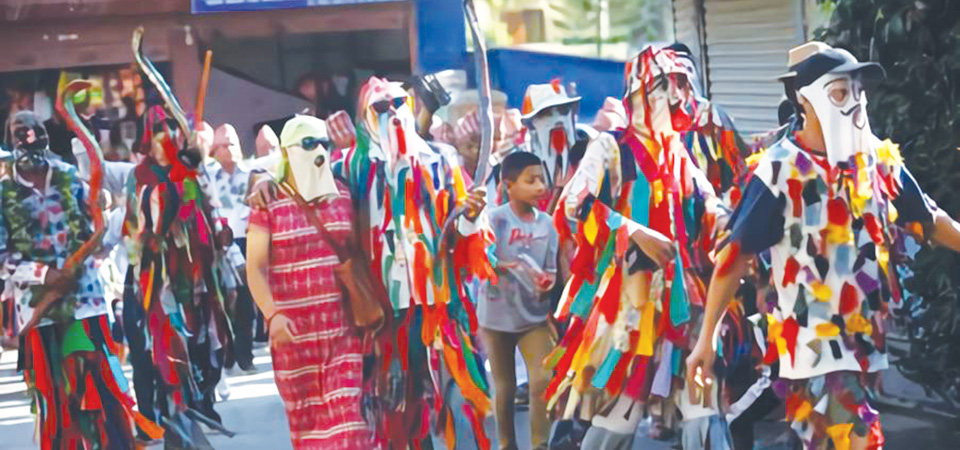Patan’s ‘journey of lights’ limited to symbolism this year

By Aashish Mishra
Lalitpur, Aug. 24: If it were not for the COVID-19 pandemic, Tuesday would have been a festive day in Patan. Hundreds would have marched around the city with candles, rice and other items of religious offering, accompanied by musical bands and merrymakers dressed as colourful characters. Patanites would have celebrated the day – the third day of the dark fortnight of Shrawan – as Mataya.
But this year, because of the health risks posed by the coronavirus and the possibility of a third wave of the pandemic hitting the country, the festival, also known as Nyaku Jatra, will be marked symbolically, stated the Nyaku Jatra Mataya Central Management Committee. Issuing a public notice, the committee informed that only priests, gurus and a limited number of people would be allowed to participate in the annual citywide procession.
This decision is also in line with Lalitpur Metropolitan City’s appeal to tone down the festivals this year to prevent the potential spread of the coronavirus. The city made the appeal after consultations with the stakeholders and various festival-related bodies.
Clarifying the decision, Lalitpur Mayor Chiri Babu Maharjan said that it was to protect the people from COVID-19. “We will definitely celebrate our festivals in a grand manner after the pandemic is over. But for now, let us only conduct them symbolically,” he said.
The decision to scale down Mataya has largely been welcomed by the locals of the core city of Patan who were disappointed when the festival was cancelled entirely last year. “We don’t mind the procession being held in a limited manner as long as it is held,” said Saroj Shrestha, a resident of Bakhumbahal. “Let us only do the bare minimum this year to ensure that the tradition is not breached. We can celebrate it properly next year or the year after that once the coronavirus recedes,” said Sankalpa Bajracharya who lives in Gwarko.
Mataya has been shortened, postponed or cancelled in previous times of distress as well, informed 87-year-old Naren Kaji Maharjan. Most recently, the octogenarian remembers the march being shortened in 2015 because of the Gorkha earthquake.
Elaborating on the meaning of the festival, Maharjan, a resident of Natole, Pulchowk, explained that the name ‘Mataya’ came from two Nepal Bhasa words ‘Mata’ and ‘Ya’. “Mata means light and Ya means Yatra or journey. So, the name Mataya literally means the journey of light,” he said.
And true to this name, people who join the procession do carry candles and flames as lights.
But there is also a second interpretation to the name which considers ‘Mataya’ a corrupted form of the word ‘Matya’ which, in Nepal Bhasa means unconquered, Maharjan shared. “Mara, the Buddhist God of Senses, did not want Siddhartha Gautam to achieve enlightenment. So, on numerous occasions, he sent his three daughters Rati, Rag and Trishna to seduce Gautam and distract him from his meditation.
However, all his efforts failed and Gautam attained enlightenment, ultimately becoming Lord Gautam Buddha.”
Maharjan added, “The festival ‘Matya’ is a celebration of how Buddha was unconquered by the temptations Mara set before him.”
Moving beyond the realm of mythology, Daniel Wright, a physician who served at the British Residency in Kathmandu from 1866 to 1877, documented the origin of this festival in his 1877 book ‘The Wright Chronicle’.
According to the book, which is based on various Nepali and Newari Vamshavalis, the Lichhavi king Gunakamdev started the Mataya festival and gave the responsibility of organising it every year to 10 localities of Patan, namely Mangal Bazar, Chakrabahil, Ikhachhén, Bubahal, Haugal, Okubahal, Ikhalakhu, Kobahal, Saugal and Nakabahil. These localities take turns to organise the festival with support from the Nyaku Jatra Mataya Central Management Committee.
This year, it was Ikhalakhu’s turn. This means that, had it not been for the pandemic, devotees from all over Kathmandu Valley would have gathered there early in the morning and started their journey, Maharjan said. “People who have recently had a death in their family are specially required to participate in Mataya because it helps accumulate merit for their deceased kin,” he said.
Tourist guide Suresh Shakya elucidated that pilgrims participating in Mataya visit more than 1,700 Hindu and Buddhist shrines in the historic settlements of Patan along with countless Bahals and Bahils. “Some people fast the whole day while some make the entire journey barefoot,” he said.
“The broader route of Mataya passes through the four principal stupas of Patan located at the four corners of the city,” Shakya informed, adding, “The stupas are Lagankhel Thur in Lagankhel, Pulchowk Thur in Pulchowk, Bagmati Thur in Kobahal and Teta Thur in Gwarko. Even though people may not be able to participate in the festival parade, they can still visit these stupas on their own in memory of their loved ones who passed away this year.”
Mataya processions, independent of the one in Patan, are also held in Bungamati, Sunakothi and Harisiddhi. They were also limited to ceremonial worship this year.
Recent News

Do not make expressions casting dout on election: EC
14 Apr, 2022
CM Bhatta says may New Year 2079 BS inspire positive thinking
14 Apr, 2022
Three new cases, 44 recoveries in 24 hours
14 Apr, 2022
689 climbers of 84 teams so far acquire permits for climbing various peaks this spring season
14 Apr, 2022
How the rising cost of living crisis is impacting Nepal
14 Apr, 2022
US military confirms an interstellar meteor collided with Earth
14 Apr, 2022
Valneva Covid vaccine approved for use in UK
14 Apr, 2022
Chair Prachanda highlights need of unity among Maoist, Communist forces
14 Apr, 2022
Ranbir Kapoor and Alia Bhatt: Bollywood toasts star couple on wedding
14 Apr, 2022
President Bhandari confers decorations (Photo Feature)
14 Apr, 2022










